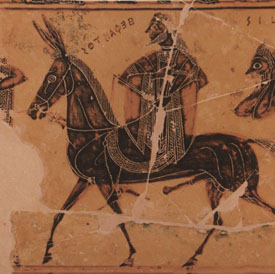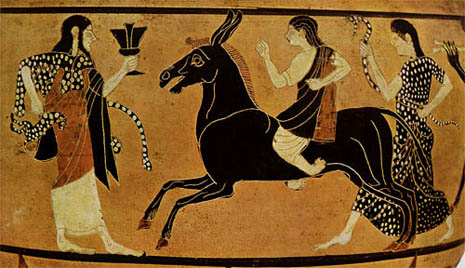Undergraduate paper finds place in prestigious journal
A William & Mary undergraduate can now claim sole authorship of a paper appearing in one of the most prestigious Hellenic journals in the world.
In “Lame Hephaistos,” published in the Annual of the British School of Athens, Maura Brennan ’15 examines the depiction of disabilities in antiquity and shines a light on some little-known portrayals of the only god of Olympus to ever fall short of physical perfection.
“I broke my foot during the spring of my freshman year, so perhaps messed up feet were on my mind,” she said.
The paper particularly looks at the portrayal of the eponymous Hephaistos, Greek god of blacksmithing. His disability came by way of his wrathful mother, Hera, who cast him out of Olympus as a youth and damaged his leg.
Brennan was able to intensely study Hephaistos while researching overseas at the Beazley Archive at Oxford University, the largest collection of Greek painted pottery in the world. That opportunity came as a result of volunteering at the Athenian Potters and Painters conference at W&M, where she met researchers from England and was invited to be an intern over the summer.
At Oxford, she was able to examine pottery, as well as writings, that told the story of Hephaistos and gain an understanding of the ways the ancient Greeks showed the disabled. The most famous example, the “François Vase,” shows the god’s feet pointing opposite directions, but Brennan discovered that wasn’t the only way he was shown.
Outside of that well-known example, Brennan also identified examples where Hephaistos’ foot had a zig-zag sole, his leg ended in a withered foot, or he simply had no foot at all.
After making those discoveries through extensive research came a year of writing back on campus, a process Brennan describes as arduous.
“At first it was really tough,” she said. “Learning to write an article like that is a very different style of writing than normal term papers … so the adjustment took some time.”
Her professor, Chancellor Professor and Forrest D. Murden, Jr. Professor of Classical Studies John Oakley, also proved to be a difficult taskmaster.
“There would be some weeks where I would come in and Professor Oakley would hand what I had written back to me and say ‘This isn’t good enough yet, come back next week with it in better shape.’ Other times he’d give it back to me covered in red ink.”
Despite the difficulty, Brennan is grateful for the process, saying that she was able to reach her own conclusions and learn how to do things for herself.
When the paper was accepted by the journal, Oakley was impressed.
“She was able to publish an article, which is really unheard of for an undergraduate,” he said. “I don’t know of any other example of an undergraduate doing that in a major journal.”
The end result was worth the effort, Brennan said.
“I could have presented it at an undergraduate conference, or had it published in an undergraduate journal, so having it accepted for publication in one of the most important professional journals for classics is insane, and wasn’t something I really thought could possibly happen.”
While the result was impressive, Oakley was not surprised.
“She discovered something new,” he said. “She was able to professionally research it and present her findings to other scholars, which is all publishing is.”
Brennan gives credit to Oakley, as well as the entire classics department, for helping her throughout this process. From courses to conferences and exhibits to a scholarship supporting her time at Oxford, William & Mary has been a supportive presence that continues into the rest of her time as a student.
“The class I took, the conference Dr. Oakley hosted, and the exhibition at the Muscarelle Museum of Art all were major factors that encouraged me to undertake that sort of research,” she said, adding that these events “have shaped how I’ve structured my time at William & Mary for the remainder of my college career.”
 Skip to main content
Skip to main content

